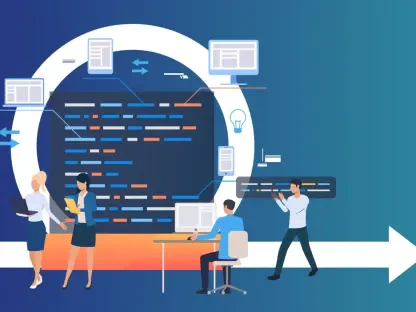Setting the Stage for Embedded Development Challenges
In an era where embedded systems power everything from smart home devices to autonomous vehicles, the complexity of modern microcontrollers (MCUs) and microprocessors (MPUs) has reached unprecedented levels, creating significant hurdles for developers. They grapple with multi-core architectures and the integration of artificial intelligence (AI) at the edge, often finding traditional tools inadequate for the task. This growing challenge underscores a critical need for advanced Integrated Development Environments (IDEs) that can streamline workflows and bridge the gap between intricate hardware and cutting-edge software demands. This review dives into the latest innovations in embedded IDEs, exploring how they address these pressing issues and reshape the landscape of embedded systems development.
Understanding the Role of Embedded IDEs
Embedded IDEs serve as comprehensive platforms that combine coding, debugging, and deployment functionalities tailored for embedded systems. These tools are essential for developers working on resource-constrained devices, providing a unified environment to manage the intricacies of low-level programming. Their evolution has been driven by the need to handle increasingly sophisticated hardware, such as multi-core processors and specialized accelerators, which demand more than basic coding support.
The significance of these environments extends beyond mere convenience, as they play a pivotal role in enabling rapid development cycles for industries reliant on real-time processing. With the advent of technologies like embedded AI, IDEs have had to adapt, incorporating features that support seamless integration of machine learning models into compact hardware. This adaptability positions them as indispensable in the broader technological ecosystem, particularly for applications in edge computing and the Internet of Things (IoT).
Key Features and Capabilities of Modern IDEs
Tackling Complex Hardware Ecosystems
Modern embedded IDEs have evolved to address the challenges posed by intricate hardware designs, including multi-core architectures and heterogeneous cores found in advanced MCUs and MPUs. These tools now offer robust support for coordinating across diverse instruction sets and memory spaces, ensuring that developers can manage complex systems without constant delays. Features like multi-core debugging allow for simultaneous monitoring of different processor elements, reducing the time spent on identifying and resolving issues.
Additionally, system planning tools embedded within these IDEs facilitate better architectural coordination by providing visual representations and automated resource allocation. Such capabilities help developers navigate the boundaries between digital signal processors (DSPs) and main cores, minimizing errors during integration. This focus on hardware compatibility marks a significant leap forward in ensuring that development keeps pace with hardware innovation.
Bridging Embedded AI Workflows
The rise of embedded AI has introduced a new layer of complexity, requiring IDEs to support workflows that connect data science with hardware deployment. Many modern platforms now integrate compatibility with popular frameworks like PyTorch and TensorFlow, enabling developers to import and adapt machine learning models directly within the development environment. This integration eliminates the need for external scripts, streamlining the process significantly.
Beyond basic compatibility, these IDEs offer advanced tools for model optimization and quantization, ensuring that AI algorithms run efficiently on resource-limited devices. Hardware mapping features further enhance this capability by aligning models with specific processor capabilities, a critical requirement for edge computing applications. These advancements demonstrate how IDEs are becoming vital in deploying intelligent systems at the edge, where real-time processing is paramount.
Cutting-Edge Advancements in IDE Technology
Recent innovations in embedded IDEs reflect a strong push by vendors to meet the evolving needs of developers through automation and AI-driven solutions. Many platforms now incorporate intelligent code generation and error detection, reducing manual workload and accelerating project timelines. This trend toward automation is complemented by vendor-specific enhancements that tailor environments to proprietary hardware, ensuring optimal performance.
Another notable shift is the industry’s demand for unified platforms that minimize tool fragmentation and provide intuitive user interfaces. Such designs aim to reduce the learning curve for new users while enhancing productivity for seasoned developers. As a result, the latest IDEs are not just tools but comprehensive ecosystems that prioritize ease of use alongside powerful functionality.
These advancements also align with broader market needs, particularly the urgency to shorten development cycles in competitive sectors. By focusing on seamless integration and user-friendly experiences, vendors are addressing long-standing pain points, positioning their IDEs as essential components in the race to innovate within embedded systems.
Practical Impacts Across Industries
The real-world applications of modern embedded IDEs span a wide array of industries, showcasing their versatility in addressing specific challenges. In the IoT sector, these tools enable developers to create efficient firmware for connected devices, ensuring low power consumption and reliable performance. Their ability to handle complex protocols and data processing makes them ideal for smart infrastructure projects.
In automotive and industrial automation, IDEs have proven instrumental in accelerating the development of safety-critical systems. For instance, their use in edge computing allows for real-time data analysis in autonomous vehicles, enhancing decision-making capabilities. Similarly, in industrial settings, these platforms support the deployment of TinyML applications, enabling predictive maintenance on machinery with minimal latency.
Specific implementations highlight tangible benefits, such as reduced time-to-market for IoT products and improved reliability in automotive control units. By providing debugging and optimization tools tailored to these use cases, embedded IDEs have become catalysts for innovation, directly impacting project outcomes and operational efficiencies across diverse fields.
Barriers to Widespread IDE Adoption
Despite their advancements, embedded IDEs face significant challenges that hinder broader adoption among developers. Tool fragmentation remains a persistent issue, with many environments tied to specific vendors, forcing teams to juggle multiple platforms for a single project. This lack of interoperability often results in inconsistent user experiences and increased error rates.
Regulatory compliance adds another layer of difficulty, as standards like IEC 62443 and the EU Cyber Resilience Act demand stringent security measures from the outset. Many IDEs lack native security features, treating them as add-ons rather than core components, which complicates adherence to these mandates. Such gaps expose systems to vulnerabilities and slow down development workflows.
Vendors are actively working to mitigate these limitations by enhancing compatibility across platforms and embedding security architectures directly into their tools. Efforts to standardize interfaces and integrate robust protective measures indicate a commitment to overcoming these hurdles, though the pace of change varies across the industry, leaving some developers in need of interim solutions.
Looking Ahead at IDE Evolution
The future of embedded IDEs appears poised for transformative growth, with potential integration of advanced AI agents that could automate entire development phases. Such agents might predict coding errors or suggest optimizations in real time, further reducing human intervention. This direction hints at a paradigm shift toward fully autonomous workflows, reshaping how projects are conceptualized and executed.
Broader cross-platform support is also on the horizon, as developers increasingly demand tools that operate seamlessly across diverse hardware and operating systems. Anticipated breakthroughs, such as enhanced security protocols embedded at the core of IDEs, could address current regulatory and vulnerability concerns, ensuring safer systems. These developments promise to elevate the reliability of embedded applications significantly.
The long-term impact on industries like IoT and edge computing could be profound, as IDE innovations enable more sophisticated and secure implementations. As these tools evolve to meet emerging needs, they are likely to drive further advancements, fostering a new wave of technological progress in connected and intelligent systems over the coming years.
Reflecting on the Journey of Embedded IDEs
Looking back, the journey of embedded IDEs reveals a remarkable adaptation to the escalating demands of hardware complexity and AI integration. Their role in unifying development experiences stands out as a strength, effectively tackling multi-core challenges and security requirements. While areas like tool fragmentation linger as points for improvement, the strides made in user interface design and workflow automation mark significant progress.
Moving forward, stakeholders should prioritize interoperability and embedded security as key focus areas to address lingering adoption barriers. Exploring partnerships between vendors for standardized platforms could offer a practical solution, ensuring developers have access to versatile tools. Additionally, investing in AI-driven features might unlock unprecedented efficiencies, setting a new benchmark for embedded development.
As the landscape continues to shift, staying attuned to regulatory changes and industry needs will be crucial for sustained innovation. Embracing these next steps could solidify the position of embedded IDEs as indispensable allies in shaping the future of technology across multiple domains, paving the way for groundbreaking applications.









